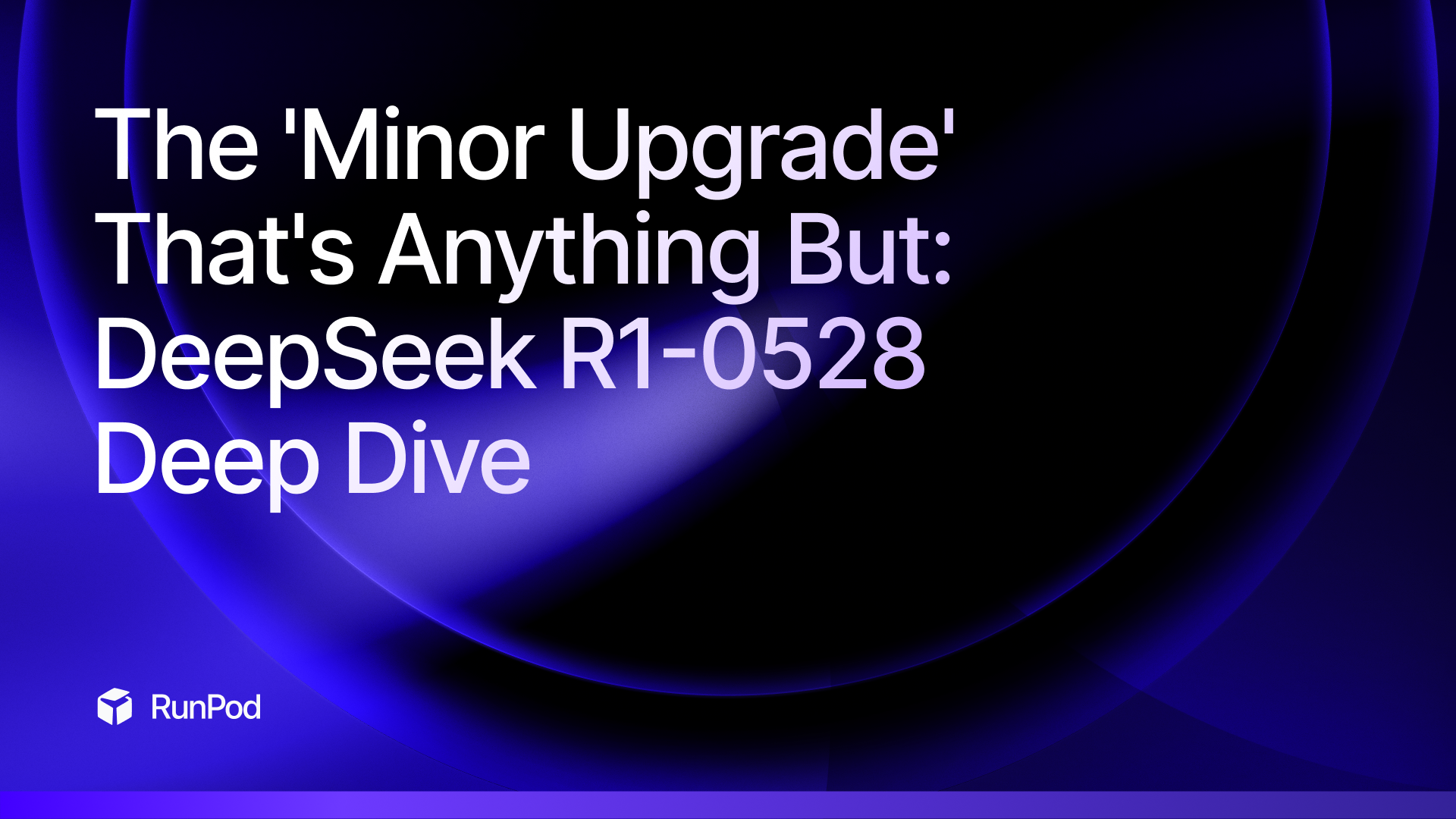The 'Minor Upgrade' That's Anything But: DeepSeek R1-0528 Deep Dive

Earlier this year, DeepSeek dropped a little, experimental reasoning model in the middle of the night that ended up taking the world by storm, shooting to the top of the App Store past closed model rivals and overloading their API with unprecedented levels of demand to the point that they actually had to stop accepting payments while they worked through deployment and technical challenges – all while being open-source, so anyone could pull and load the model on any hardware they wished, even on RunPod. Since then, it has held its own as an open-source option even in the face of closed-source, foundational model upgrades.
Again, earlier this week, true to form, an upgrade was released with little fanfare or preparation. Like its predecessor, DeepSeek-R1-0528 continues to utilize a Mixture-of-Experts (MoE) architecture, now scaled up to an enormous size. This sparse activation allows for powerful specialized expertise in different coding domains while maintaining efficiency. The context also continues to remain at 128k (with RoPE scaling or other improvements capable of extending it further.)
The team refers to it as a "minor upgrade" – and at first blush this does appear to be an incremental update of some kind – but what it is it really?
Mathematics and Complex Reasoning: A Quantum Leap in Analytical Power
DeepSeek R1-0528's mathematical reasoning capabilities represent perhaps the most dramatic improvement in the update. In the AIME 2025 test, the model's accuracy has increased from 70% in the previous version to 87.5% in the current version - a remarkable 17.5 percentage point jump that puts it in direct competition with OpenAI's o3 (88.9%) and well ahead of Gemini 2.5 Pro (83.0%).

The improvements stem from what DeepSeek calls "enhanced thinking depth." In the AIME test set, the previous model used an average of 12K tokens per question versus 23K tokens in the new version, signaling that the model now engages in much longer, more thorough chains of reasoning. This isn't just about brute force computation - it's about systematic, step-by-step logical analysis.
What sets R1-0528 apart is its ability to handle complex, multi-step mathematical problems that require not just computational ability but genuine mathematical insight. his means the model can check its own work, recognize errors, and course-correct during problem-solving.
Perhaps most impressively, the chain-of-thought from DeepSeek-R1-0528 was distilled to post-train Qwen3 8B Base, obtaining DeepSeek-R1-0528-Qwen3-8B. This model achieves state-of-the-art (SOTA) performance among open-source models on the AIME 2024, surpassing Qwen3 8B by +10.0% and matching the performance of Qwen3-235B-thinking. This suggests that the mathematical reasoning patterns discovered by R1-0528 can be successfully transferred to smaller, more efficient models - something demonstrated previously in the original R1 model and now confirmed through iteration.
Code Generation and Programming: Rivaling the Best Proprietary Models
LiveCodeBench: The Gold Standard Achievement
On the Live CodeBench challenge platform, DeepSeek-R1-0528 achieved a Pass@1 score of 73.1, placing 4th overall – just shy of OpenAI's "O3 (High)" model at 75.8 and the "O4-Mini (High)" at 80.2. This performance is particularly significant because LiveCodeBench doesn't just test static performance, it challenges a model's dynamic reasoning, its ability to write, iterate, and debug code in realistic software development scenarios.

Specialized Coding Applications
For companies building AI agents that handle PR reviews, Deep Code Review, code refactoring, or real-time developer assistance, the release of DeepSeek-R1-0528 is more than just a benchmark win—it's a practical leap forward. The benchmark is designed to mimic real-world dev scenarios, including PR reviews, iterative debugging, and multi-step reasoning
Reduced Hallucinations: A Major Reliability Breakthrough
One of the most significant practical improvements in R1-0528 is the dramatic reduction in AI hallucinations - those troublesome instances where models generate plausible-sounding but factually incorrect information.
Quantified Hallucination Reduction
DeepSeek said the rate of "hallucinations", false or misleading output, was reduced by about 45-50% in scenarios such as rewriting and summarizing. This isn't just a marginal improvement - it's a fundamental enhancement to the model's reliability and trustworthiness. According to Adina Yakefu, AI researcher at Huggingface, the upgraded model also has "major improvements in inference and hallucination reduction ... this version shows DeepSeek is not just catching up, it's competing." The improvements appear to stem from more consistent factual grounding and lower error rates in multi-step reasoning.
Technical Implementation
The hallucination reduction appears to be achieved through several mechanisms:
- Enhanced verification processes: Beyond its improved reasoning capabilities, this version also offers a reduced hallucination rate, enhanced support for function calling, and better experience for vibe coding.
- Improved algorithmic optimization: DeepSeek explains in its new model card on HuggingFace that these enhancements stem from leveraging increased computational resources and applying algorithmic optimizations in post-training.
- Better factual grounding: More consistent factual grounding and lower error rates in multi-step reasoning.
Personal Impressions
As someone that has experimented with training and studying how LLMs can be used as creative writing partners since the days of Pygmalion-6b, along with extensive experience using the vanilla R1 for the same, here are my thoughts:
- R1 was creative – insanely creative for an LLM, moreso than any LLM I had used prior to that date. It was wild, unhinged, spontaneous, and funny in ways that no LLM had managed to achieve up to that date. However, it had a major flaw in that it was not coherent and despite that creativity it would not make choices that logically followed. Additionally, it was often very resistant to prompting and direction. Essentially, it was wild, creative, unpredictable, but often just kind of did what it wanted.
- R1-0528 sacrifices a small amount of that unhinged wild humanity to gain a large amount of coherence - a worthwhile tradeoff in my book. To be honest, I have a theory that a lot of its creativity was induced by its willingness to hallucinate, which a human could interpret as being one in the same if the stars happened to align in the output.
- Claude Opus 4 is currently the reigning king for human-level output in writing - but considering that a dollar gets you a mere 65k input tokens, you're going to need a second mortgage for any large scale projects with it. In terms of actual feasibility, the open source R1-0528 will definitely outclass it.
Deploying on RunPod
KoboldCPP remains the fastest and quickest way to spin up a pod to use quantizations at a fraction of a spend the full weights would cost, since this model is just as weighty as the original R1. Running a model at 8 bit incurs next to no performance tradeoffs while requiring only half of the original hardware, with lower bit quantizations often being just as useful. Check out our previous guide on running this if you'd like to get started, and use the Unsloth GGUF quantizations as a starting point.

Questions? Try out our Discord - we'd be happy to hear from you!

